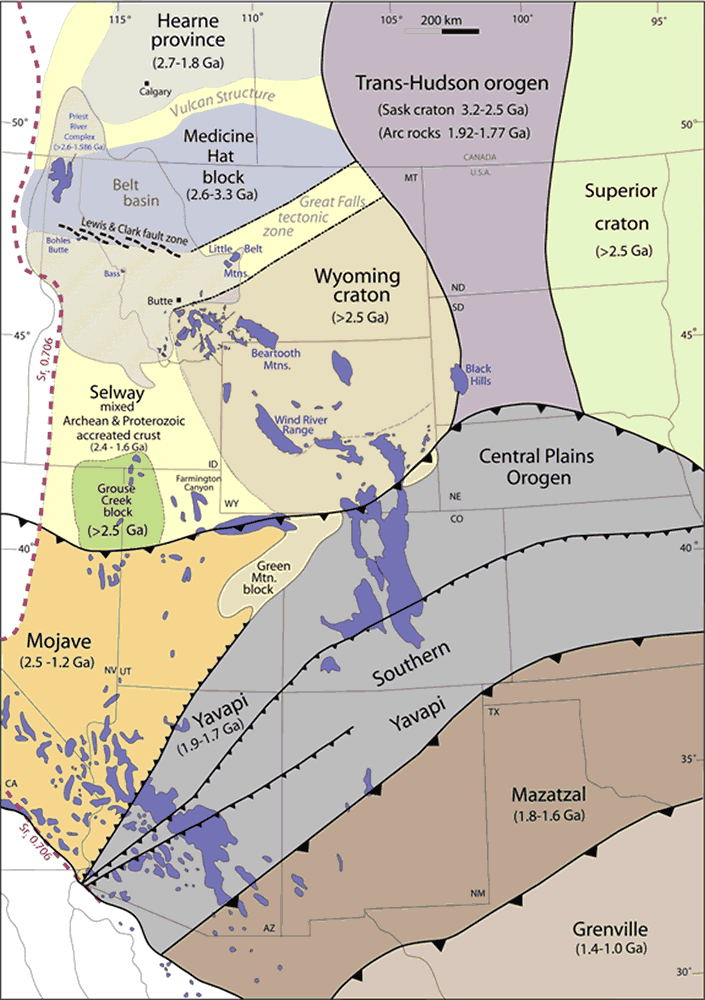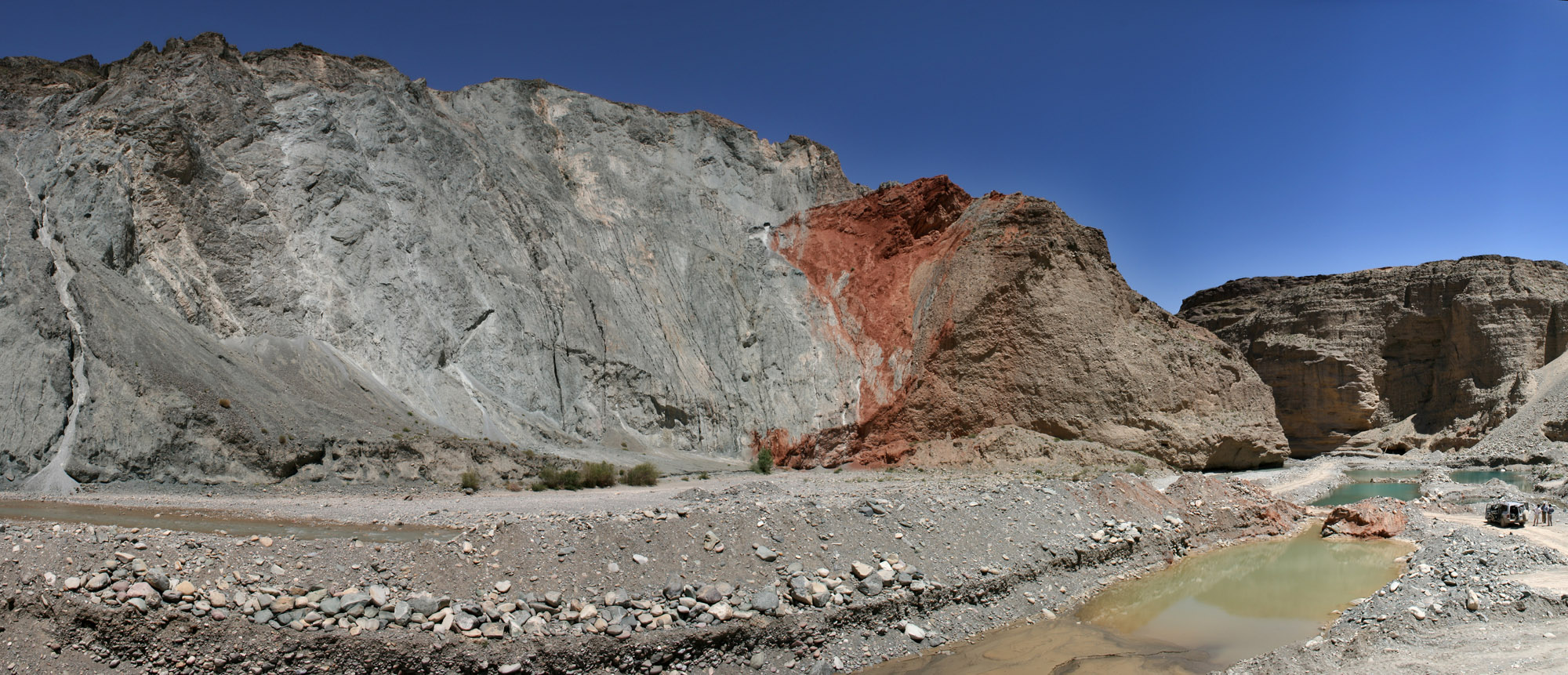|
Yavapai Orogeny
The Yavapai orogeny was an orogenic (mountain-building) event in what is now the Southwestern United States that occurred between 1710 and 1680 million years ago ( Mya), in the Statherian Period of the Paleoproterozoic. Recorded in the rocks of New Mexico and Arizona, it is interpreted as the collision of the 1800-1700 Mya age Yavapai island arc terrane with the proto-North American continent. This was the first in a series of orogenies within a long-lived convergent boundary along southern Laurentia that ended with the ca. 1200–1000 Mya Grenville orogeny during the final assembly of the supercontinent Rodinia, which ended an 800-million-year episode of convergent boundary tectonism. Description Age and isotope data show that southern North America is composed of a series of northeast-trending provinces representing island arc terranes accreted onto the 1800 Mya core of Laurentia. These are the Yavapai province (1800–1700 Mya), the Mazatzal province (1700–1650 Mya), the Gra ... [...More Info...] [...Related Items...] OR: [Wikipedia] [Google] [Baidu] |
Mazatzal Orogeny
The Mazatzal orogeny was an orogenic event in what is now the Southwestern United States from 1650 to 1600 Mya in the Statherian Period of the Paleoproterozoic. Preserved in the rocks of New Mexico and Arizona, it is interpreted as the collision of the 1700-1600 Mya age Mazatzal island arc terrane with the proto-North American continent. This was the second in a series of orogenies within a long-lived convergent boundary along southern Laurentia that ended with the ca. 1200–1000 Mya Grenville orogeny during the final assembly of the supercontinent Rodinia, which ended an 800-million-year episode of convergent boundary tectonism. Description Age and isotope data show that southern North America is composed of a series of northeast-trending provinces representing island arc terranes accreted onto the 1800 Mya core of Laurentia. These are the Yavapai province (1800–1700 Mya), the Mazatzal province (1700–1650 Mya), the Granite-Rhyolite province (1500–1300 Mya), and the L ... [...More Info...] [...Related Items...] OR: [Wikipedia] [Google] [Baidu] |
SWEAT (hypothesis)
SWEAT (which stands for Southwestern United States and East Antarctica) is the hypothesis that the Southwestern United States was at one time connected to East Antarctica. The hypothesis of a late Precambrian fit of western North America with the Australia-Antarctic shield region permits the extension of many features through Antarctica and into other parts of Gondwana. For example, the Grenville orogen may extend around the coast of East Antarctica into India and Australia, and the ophiolitic belt of the latter may extend into East Antarctica. The Wopmay orogen of northwest Canada may extend through eastern Australia into Antarctica and thence beneath the ice to connect with the Yavapai- Mazatzal orogens of the southwestern United States. Counterparts of the Precambrian-Paleozoic sedimentary rocks along the U.S. Cordilleran miogeocline may be present in the Transantarctic Mountains. Orogenic belt boundaries provide useful piercing points for Precambrian continental recons ... [...More Info...] [...Related Items...] OR: [Wikipedia] [Google] [Baidu] |
Albany-Fraser Orogeny
The Albany-Fraser orogeny was an orogenic event which created the Albany-Fraser Orogen in what is now Australia between 2.63 and 1.16 billion years ago, during the late Archean and Proterozoic. Tectonic history developed from isotope dating suggests that the orogeny occurred as the combined North Australia Craton-West Australia Craton collided with the East Antarctic-South Australian Craton. The Kepa Kurl Booya Province, including its component zones, the Fraser Zone, Nornalup Zone and Biranup Zone represents the crystalline basement of the orogen. Numerous theories and hypotheses have been presented about the orogeny. For example, in 2011 geochronology dating of 1.71 to 1.65 billion year old granite and gabbro intrusions in the Biranup Zone suggested craton margin rocks rather than a previously interrupted small terrane wedged against the Yilgarn Craton. In other cases, researchers attempting to reconstruct the supercontinent Rodinia suggested a possible connection between Austral ... [...More Info...] [...Related Items...] OR: [Wikipedia] [Google] [Baidu] |
Baltica
Baltica is a paleocontinent that formed in the Paleoproterozoic and now constitutes northwestern Eurasia, or Europe north of the Trans-European Suture Zone and west of the Ural Mountains. The thick core of Baltica, the East European Craton, is more than three billion years old and formed part of the Rodinia supercontinent at 1 . Tectonic history Baltica formed at 2.0–1.7 Ga by the collision of three Archaean-Proterozoic continental blocks: Fennoscandia (including the exposed Baltic Shield), Sarmatia ( Ukrainian Shield and Voronezh Massif), and Volgo-Uralia (covered by younger deposits). Sarmatia and Volgo-Uralia formed a proto-craton (sometimes called "Proto-Baltica") at c. 2.0 Ga which collided with Fennoscandia c. 1.8–1.7 Ga. The sutures between these three blocks were reactivated during the Mesoproterozoic and Neoproterozoic. 750–600 million years ago, Baltica and Laurentia rotated clockwise together and drifted away from the Equato ... [...More Info...] [...Related Items...] OR: [Wikipedia] [Google] [Baidu] |
Norwegian Journal Of Geology
''Norwegian Journal of Geology'' ( no, Norsk Geologisk Tidsskrift) is a quarterly peer-reviewed scientific journal In academic publishing, a scientific journal is a periodical publication intended to further the progress of science, usually by reporting new research. Content Articles in scientific journals are mostly written by active scientists such as s ... published by the Norwegian Geological Society. The scope of the journal is the geology of Norway, the Arctic, and nearby seas. The journal adopted the Creative Commons Attribution License for published works since volume 94, issue 4 (2014). Abstracting and indexing The journal is abstracted and indexed in: See also * ''Fennia'' *'' Geografiska Annaler'' *'' Norwegian Journal of Geography'' References External links * Geology journals Multilingual journals Norwegian-language journals English-language journals 1905 establishments in Norway Publications established in 1905 Quarterly journals Creative ... [...More Info...] [...Related Items...] OR: [Wikipedia] [Google] [Baidu] |
Gothian Orogeny
The Gothian orogeny ( sv, Gotiska orogenesen) or Kongsberg orogeny was an orogeny in western Fennoscandia that occurred between 1750 and 1500 million years ago. It precedes the younger Sveconorwegian orogeny that has overprinted much of it. The Gothian orogeny formed along a subduction zone and resulted in the formation of calc-alkaline igneous rocks 1700 to 1550 million years ago, including some of the younger members of the Transscandinavian Igneous Belt. The deformation associated with the orogeny can be seen in meta tonalite, paragneiss and biotite Biotite is a common group of phyllosilicate minerals within the mica group, with the approximate chemical formula . It is primarily a solid-solution series between the iron-endmember annite, and the magnesium-endmember phlogopite; more alumino ... orthogneisses in southeast Norway. These rocks were all subject to amphibolite facies metamorphism. Footnotes References * * {{Geology of Europe Orogenies of Europe Pale ... [...More Info...] [...Related Items...] OR: [Wikipedia] [Google] [Baidu] |
Paleomagnetism
Paleomagnetism (or palaeomagnetismsee ), is the study of magnetic fields recorded in rocks, sediment, or archeological materials. Geophysicists who specialize in paleomagnetism are called ''paleomagnetists.'' Certain magnetic minerals in rocks can record the direction and intensity of Earth's magnetic field at the time they formed. This record provides information on the past behavior of the geomagnetic field and the past location of tectonic plates. The record of geomagnetic reversals preserved in volcanic and sedimentary rock sequences (magnetostratigraphy) provides a time-scale that is used as a geochronologic tool. Evidence from paleomagnetism led to the revival of the continental drift hypothesis and its transformation into the modern theory of plate tectonics. Apparent polar wander paths provided the first clear geophysical evidence for continental drift, while marine magnetic anomalies did the same for seafloor spreading. Paleomagnetic data continues to extend th ... [...More Info...] [...Related Items...] OR: [Wikipedia] [Google] [Baidu] |
Neoproterozoic
The Neoproterozoic Era is the unit of geologic time from 1 billion to 538.8 million years ago. It is the last era of the Precambrian Supereon and the Proterozoic Eon; it is subdivided into the Tonian, Cryogenian, and Ediacaran periods. It is preceded by the Mesoproterozoic Era and succeeded by the Paleozoic Era of the Phanerozoic Eon. The most severe glaciation known in the geologic record occurred during the Cryogenian, when ice sheets may have reached the equator and formed a " Snowball Earth". The earliest fossils of complex multicellular life are found in the Ediacaran Period. These organisms make up the Ediacaran biota, including the oldest definitive animals in the fossil record. According to Rino and co-workers, the sum of the continental crust formed in the Pan-African orogeny and the Grenville orogeny makes the Neoproterozoic the period of Earth's history that has produced most continental crust. Geology At the onset of the Neoproterozoic the supercon ... [...More Info...] [...Related Items...] OR: [Wikipedia] [Google] [Baidu] |
Thrust Fault
A thrust fault is a break in the Earth's crust, across which older rocks are pushed above younger rocks. Thrust geometry and nomenclature Reverse faults A thrust fault is a type of reverse fault that has a dip of 45 degrees or less. If the angle of the fault plane is lower (often less than 15 degrees from the horizontal) and the displacement of the overlying block is large (often in the kilometer range) the fault is called an ''overthrust'' or ''overthrust fault''. Erosion can remove part of the overlying block, creating a ''fenster'' (or '' window'') – when the underlying block is exposed only in a relatively small area. When erosion removes most of the overlying block, leaving island-like remnants resting on the lower block, the remnants are called ''klippen'' (singular '' klippe''). Blind thrust faults If the fault plane terminates before it reaches the Earth's surface, it is referred to as a ''blind thrust'' fault. Because of the lack of surface evidence, blind ... [...More Info...] [...Related Items...] OR: [Wikipedia] [Google] [Baidu] |
Rhyolite
Rhyolite ( ) is the most silica-rich of volcanic rocks. It is generally glassy or fine-grained ( aphanitic) in texture, but may be porphyritic, containing larger mineral crystals ( phenocrysts) in an otherwise fine-grained groundmass. The mineral assemblage is predominantly quartz, sanidine, and plagioclase. It is the extrusive equivalent to granite. Rhyolitic magma is extremely viscous, due to its high silica content. This favors explosive eruptions over effusive eruptions, so this type of magma is more often erupted as pyroclastic rock than as lava flows. Rhyolitic ash-flow tuffs are among the most voluminous of continental igneous rock formations. Rhyolitic tuff has been extensively used for construction. Obsidian, which is rhyolitic volcanic glass, has been used for tools from prehistoric times to the present day because it can be shaped to an extremely sharp edge. Rhyolitic pumice finds use as an abrasive, in concrete, and as a soil amendment. Description R ... [...More Info...] [...Related Items...] OR: [Wikipedia] [Google] [Baidu] |
Quartzite
Quartzite is a hard, non- foliated metamorphic rock which was originally pure quartz sandstone.Essentials of Geology, 3rd Edition, Stephen Marshak, p 182 Sandstone is converted into quartzite through heating and pressure usually related to tectonic compression within orogenic belts. Pure quartzite is usually white to grey, though quartzites often occur in various shades of pink and red due to varying amounts of hematite. Other colors, such as yellow, green, blue and orange, are due to other minerals. The term ''quartzite'' is also sometimes used for very hard but unmetamorphosed sandstones that are composed of quartz grains thoroughly cemented with additional quartz. Such sedimentary rock has come to be described as orthoquartzite to distinguish it from metamorphic quartzite, which is sometimes called metaquartzite to emphasize its metamorphic origins. Quartzite is very resistant to chemical weathering and often forms ridges and resistant hilltops. The nearly pure silica co ... [...More Info...] [...Related Items...] OR: [Wikipedia] [Google] [Baidu] |





